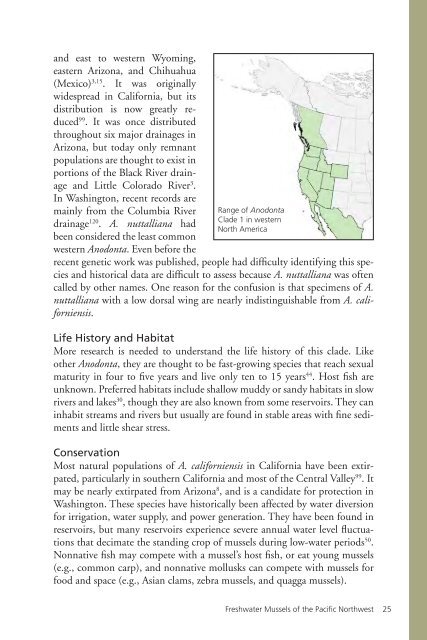Freshwater Mussels Pacific Northwest - The Xerces Society
Freshwater Mussels Pacific Northwest - The Xerces Society
Freshwater Mussels Pacific Northwest - The Xerces Society
Create successful ePaper yourself
Turn your PDF publications into a flip-book with our unique Google optimized e-Paper software.
and east to western Wyoming,<br />
eastern Arizona, and Chihuahua<br />
(Mexico) 3,15 . It was originally<br />
widespread in California, but its<br />
distribution is now greatly reduced<br />
99 . It was once distributed<br />
throughout six major drainages in<br />
Arizona, but today only remnant<br />
populations are thought to exist in<br />
portions of the Black River drainage<br />
and Little Colorado River 3 .<br />
In Washington, recent records are<br />
mainly from the Columbia River<br />
drainage 120 . A. nuttalliana had<br />
been considered the least common<br />
western Anodonta. Even before the<br />
Range of Anodonta<br />
Clade 1 in western<br />
North America<br />
recent genetic work was published, people had difficulty identifying this species<br />
and historical data are difficult to assess because A. nuttalliana was often<br />
called by other names. One reason for the confusion is that specimens of A.<br />
nuttalliana with a low dorsal wing are nearly indistinguishable from A. californiensis.<br />
Life History and Habitat<br />
More research is needed to understand the life history of this clade. Like<br />
other Anodonta, they are thought to be fast-growing species that reach sexual<br />
maturity in four to five years and live only ten to 15 years 44 . Host fish are<br />
unknown. Preferred habitats include shallow muddy or sandy habitats in slow<br />
rivers and lakes 30 , though they are also known from some reservoirs. <strong>The</strong>y can<br />
inhabit streams and rivers but usually are found in stable areas with fine sediments<br />
and little shear stress.<br />
Conservation<br />
Most natural populations of A. californiensis in California have been extirpated,<br />
particularly in southern California and most of the Central Valley 99 . It<br />
may be nearly extirpated from Arizona 8 , and is a candidate for protection in<br />
Washington. <strong>The</strong>se species have historically been affected by water diversion<br />
for irrigation, water supply, and power generation. <strong>The</strong>y have been found in<br />
reservoirs, but many reservoirs experience severe annual water level fluctuations<br />
that decimate the standing crop of mussels during low-water periods 50 .<br />
Nonnative fish may compete with a mussel’s host fish, or eat young mussels<br />
(e.g., common carp), and nonnative mollusks can compete with mussels for<br />
food and space (e.g., Asian clams, zebra mussels, and quagga mussels).<br />
<strong>Freshwater</strong> <strong>Mussels</strong> of the <strong>Pacific</strong> <strong>Northwest</strong> 25

















